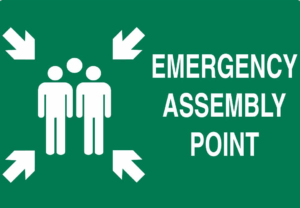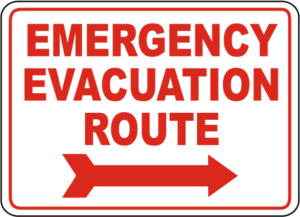Emergencies are unpredictable, and they can happen at any time, anywhere. An emergency situation could range from natural disasters such as earthquakes, floods, or hurricanes, to man-made disasters such as explosions, fires, gas leaks, or chemical spills. Whatever the type of emergency, it is important to have a well-planned emergency evacuation procedure in place to ensure the safety of all employees and visitors on site. In this article, we will discuss the definition, purpose, categories, emergency response, siren types, and evacuation procedure.
Purpose, Definition of terms and Categories of Emergencies :
Purpose:
The purpose of Emergency evacuation procedure is to protect the employees from serious injury, property loss, or loss of life, in the event of an actual or potential emergency event.
Definition of Emergency:
An emergency is an unexpected and potentially dangerous situation that requires immediate action to minimize harm to people, property, or the environment. In simple word : Accidents or major incident, gas leaks, fire inside the refinery.
Definition of Evacuation:
Emergency evacuation is the process of moving people from a dangerous location to a safer one. The purpose of an emergency evacuation procedure is to protect employees from serious injury, property loss, or loss of life in the event of an actual or potential emergency event.
Assembly Point
An assembly point is a designated location, typically outside of a building or facility, where individuals gather in the event of an emergency or evacuation. It is a predetermined location that is chosen because it is a safe and easily identifiable place where people can meet after they have evacuated a building or area. Assembly points are important for ensuring that everyone can be accounted for during an emergency and for allowing emergency responders to assess the situation and provide assistance if necessary. It is crucial to know the location of the assembly point beforehand and to follow any instructions or procedures provided during an emergency.

Emergency Categories:
This section covers the emergency categorization philosophy and predefined response for different types of emergency incidents, such as:
- Fire
- Oil Spills
- Gas Release (Toxic/Flammable)
- Hazardous Chemical Spills
- Personnel Injuries
- Security Incidents
The purpose of categorizing incidents is to ensure that sufficient (and appropriate) resources are immediately made available to bring the emergency under control as quickly and efficiently as possible.
There are emergency situations which have the potential to affect personnel lives, for example:
- Explosion
- Release of toxic gas
- Release of flammable gas, oil or other material having potential to cause fire or leading to fire
- Fire
- Release of toxic or flammable gas
- Nuclear, Biological or Chemical (NBC) attack
- Bomb threat, sabotage, air raid or other hostile act
Emergency Response
The first person reaching at the incident site will call Emergency Number of a client to confirm the incident without waiting for categorization. HSE Supervisor assesses the situation, categorize the incident and inform EDC advising the type and category of the incident.
Action Plan In Case of Emergency:
- Don’t Panic: In case of an emergency, it is important to stay calm and focused. Panicking can lead to confusion and hinder the evacuation process.
- Stop All Work and Report Immediately to Emergency Team: All personnel must stop any work immediately and report to the emergency team. This ensures that everyone is accounted for and can evacuate safely.
- Switch off All Equipment / Vehicles in Use: All equipment and vehicles in use should be switched off to avoid any potential hazards during the evacuation.
- Evacuate the Work Area: Personnel must evacuate the work area as soon as possible to avoid any further danger. It is important to follow the evacuation routes and signs that have been established to ensure a safe evacuation.
- Do Not Run but Move Quickly Towards the Designated Muster/Assembly Point: Personnel should move quickly towards the designated muster/assembly point but should not run as it can cause accidents and injuries.
- Stay at the Gathering Point and Wait for Further Instructions from Your Supervisor after Headcount
EMERGENCY SIREN TYPES
An emergency siren system is essential in any facility or workplace to alert personnel of any emergency situation. The system may differ from one client to another, but the basic components are:
- Alert Siren: An interrupted [on/off] tone sounded to announce an emergency such as fire explosion, major oil leak, or an uncontrolled toxic gas release [whether originating onsite or from the neighbor industries].
- Evacuation Siren: A wailing tone sounded when evacuation is declared.
- All Clear Siren : A continuous uninterrupted tone sounded to declare the incident closeout.
It is important for all personnel to know the different siren sounds and their corresponding meanings to ensure a timely and safe evacuation.
**Note: Above mentioned emergency sirens system is as per KNPC. The emergency siren system can differ as per client.
Emergency Evacuation Procedure based upon sirens
Alert Siren :
If the Alert Siren is activated, the following actions should be taken in both the office and the work site:
Activities at Site:
- Upon hearing the emergency alert siren, supervisors should inform their team to stop all critical activities. Any dangerous mechanical and electrical equipment should be switched off immediately.
- The HSE Supervisor should ensure that all dangerous mechanical and electrical equipment is switched off.
- Drivers should contact the Vehicle Controller to confirm where to collect employees when the evacuation siren sounds.
- The confined space attendant should ensure that all employees working inside the confined space come out when an alert siren is raised.
- Site supervisors should give clear instructions to workers about the wind direction, emergency routes, and alternative routes to lead site employees towards the Assembly Point.

Activities at site office:
- On hearing of emergency alert siren all Site Office Employees shall stop all working activities like switch off the computer, A/C, and wait for further evacuation siren.
- Vehicle Controller shall inform Drivers to get ready for an emergency.
- The bus driver shall be ready to collect Site Employees from the site.
Evacuation Siren
If Emergency dispatch center raise Evacuation siren then follow:
Activities at Site:
- On hearing the evacuation siren as per Site Supervisors instruction all Site Employees working in the site shall move towards assembly point in the site.
- While moving Employees shall observe the wind direction from the windsocks located a nearby area in the site and move perpendicular to the wind direction to assembly point.
- The bus driver shall start the bus from Site Office and move towards the gathering area.
- The bus driver shall park without obstructing any fire hydrant or blocking the road to collect the Site Employees in the site.
- HSE Supervisor shall ensure that all Site Employees are getting inside the bus.
Activities at the office:
- On hearing of evacuation siren, all Site Office Employees and visitors shall move towards Site Office assembly point.
- All Site Office Employees from Site Office shall move towards assembly point.
- Fire warden will ensure that no one remaining in the Site Office.
- Fire warden will ensure that the main power switch is off.
Activities at the Assembly Point:
- All Employees shall be stand in single line in contractor area at assembly point.
- Safety Engineer shall ensure that all employees are in a single line at assembly point.
- Starts the headcount at assembly point.
- While head counting if any Employees missing then immediately inform about the missing employees to Client.
- Wait for the feedback from Client Representative.
All Clear Sren:
- All clear siren is announced by the EDC after the end of the emergency.
- Site Office Employees shall move to Site Office and Site Employees shall move to the site after All clear Siren.
- Prepare new work permit before continuing their task.
- Before continuing task special toolbox talks shall be conduct about the emergency situation to the Employees at by HSE .
Conclusion
emergency evacuation procedures are critical for the safety and well-being of everyone involved in a workplace or site. It is crucial to have a well-defined emergency response plan in place to ensure a swift and efficient response to any emergency situation. The article discusses the emergency response plan for an incident site, including the actions to be taken in case of an emergency, the different types of emergency sirens, and the activities that should be carried out during an emergency.
It is essential to remain calm and follow the instructions provided by the emergency team during an emergency. All work should be stopped immediately, and all equipment and vehicles should be switched off to prevent any potential hazards. The designated muster or assembly point should be evacuated promptly and efficiently, and employees should not run but move quickly towards the gathering point. The emergency sirens, including the alert siren, evacuation siren, and all-clear siren, should be recognized and understood by all employees.
In addition, site supervisors and employees should be given clear instructions about the emergency route and alternative routes to lead employees towards the assembly point. Safety engineers should ensure that all employees are standing in a single line at the assembly point, and a headcount should be conducted to ensure that no one is missing. Special toolbox talks should also be conducted before continuing any task to inform employees about the emergency situation.
Overall, emergency evacuation procedures are critical in ensuring the safety and well-being of everyone involved in a workplace
